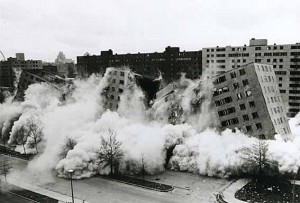One of the featured events at the SACRPH conference in Baltimore was a screening of the new documentary “The Pruitt-Igoe Myth,” detailing the rise and fall of the notorious public housing project in St. Louis that was demolished only 17 years after its highly-touted  construction in 1955. The American Historical Association has recently recognized the film, which features two active members of SACRPH, Robert Fishman and president-elect Joseph Heathcott, with its John O’Connor Film award.
construction in 1955. The American Historical Association has recently recognized the film, which features two active members of SACRPH, Robert Fishman and president-elect Joseph Heathcott, with its John O’Connor Film award.
No doubt, the film will gain additional additional attention for its stark protrayal of a dream gone sour of decent housing for poor people otherwise confined to ghetto conditions. Interviews with former residents serve as powerful testimony to the anguish that followed as conditions in the facility deteriorated. Some time in those 17 years, the modernist building with so many built-in amenities, began to deteriorate significantly, as funds for maintenance declined. Social conditions also declined at much the same time, as public spaces, especially stairwells and parks, became dangerous when shorn of common and productive purposes. Caps on the income of residents and rules barring husbands from residing with families on public assistance, in addition to the rising concentration of poverty in St. Louis as a whole, added to the problem.
The film conveys well the tragedy at Pruitt-Igoe, but what myth does it debunk? The strongest lesson taken away from this particular experiment in public housing over time has been a move away from high-rise housing and towards more “defensible spaces,” as the sociologist Oscar Newman defined the term. His name does not come up in the film, and though a failure in maintenance is suggested, it is not blamed entirely for Pruitt-Igoe’s decline. Rather, other factors are suggested, but not weighed one against another. In short, while the film conveys well the hopes invested in pubic housing, not just by civic boosters but residents themselves, it falls short of identifying the cause of decline either for this particular project for for public housing more generally.
New York City, according to a thorough study by Nicholas Dagen Bloom, did not suffer the same collapse of facilities because it continued to invest in maintenance. Was that the problem in St. Louis alone? Or did other specific factors undercut the building’s prospects, notably cost-cutting construction techniques? If all public housing suffered as poverty rose inside and outside such facilities, why was Pruitt-Igoe’s example so extreme? Michael Kimmelman offers one explanation in his column for January 26 in the New York Times.
Years ago, defending his pioneer 1939 documentary “The City,”from criticism leveled by Lewis Mumford, on whose book, The Culture of Cities, much of the film was based, producer Ralph Steiner countered: sociologists don’t make good films. It was Mumford’s contention in turn that fillmmakers, even with the best of consultation, can confuse the issue. That’s what happened here. The filmmakers have produced a powerful but mixed message about public housing that is not likely to advance the public’s understanding of the lessons to be drawn from this tragedy. As such, the film represents something of a lost opportunity to define better both the need for public investment in housing and why we should be smarter about those decisions than we were in 1955.